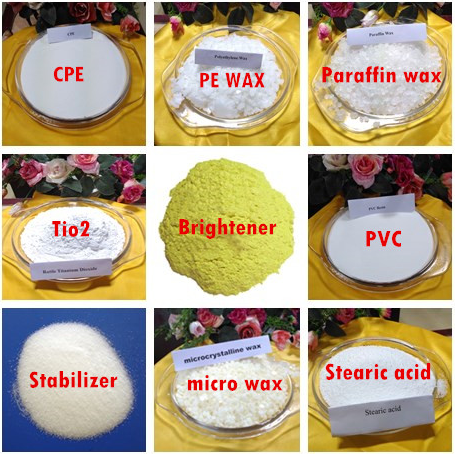CPE is chlorinated polyethylene, which is prepared by chlorination of special high-density polyethylene (HDPE). It is the product of partially replacing the hydrogen atom on the molecular chain of HDPE with chlorine atom. It is white powder after drying and non-toxic.
CPE molecular formula: CH2-CHCl-CH2-CH2] n
English abbreviation: CPE or CM chlorinated polyethylene (CPE) is a saturated polymer material.
characteristic
Because CPE molecule does not contain double chain, it has good weather resistance, flame resistance and thermal stability, which is superior to PVC, low cost and excellent performance. Soluble in aromatics and halogenated hydrocarbons, insoluble in aliphatic hydrocarbons, decomposed above 170 ℃, and released hydrogen chloride gas. It has stable chemical structure, excellent aging resistance, flame resistance, cold resistance, weather resistance, free coloration, chemical resistance, ozone resistance, electrical insulation, and good compatibility and processability. It can be mixed with PVC, PE, PS and rubber to improve its physical properties.
Three factors affecting CPE performance
First, the type of PE used ---- CPE obtained from high molecular weight polyethylene has high viscosity and tensile strength, but the adhesion between CPE and
PVC Resin is low. CPE obtained from low molecular weight polyethylene has low viscosity and tensile strength, and CPE obtained from high density polyethylene has good heat resistance.
Second: the size of raw material particles ----- the size is too small to form jelly or agglomerate CPE, and the chlorine distribution is uneven when the particle size is too large, which is difficult to dissolve in organic solvents, and the particle size range is 0.1-200 μ M is the best.
Third, the chlorination degree of CPE - when the chlorine content is below 25%, it has poor compatibility with PVC and cannot be used as a modifier; When the chlorine content is more than 40%, it has good compatibility with PVC and can be used as solid plasticizer, not as
Impact Modifier; CPE with chlorine content of 36-38% has good elasticity and compatibility with PVC, so it is widely used as PVC impact modifier. At present, CPE with 35% chlorine content is the most widely used. CPE with about 35% chlorine content has low crystallinity and glass transition temperature, good rubber elasticity, and suitable compatibility with PVC. It is widely used as an impact modifier for PVC hard products.
Production technology of CPE
CPE is mainly produced by suspension method, which can be divided into aqueous phase method and hydrochloric acid phase method. The water phase method has high utilization rate of chlorine gas, stable chlorine content in the product, but serious equipment corrosion and large amount of three wastes. The hydrochloric acid phase method is the most advanced production method, with short process knowledge, stable product quality and low three wastes.
Selection of CPE impact modifier
1) Domestic CPE models are generally identified by such as 135A, 135B, 140B, 239C, etc. The first digit 1 and 2 represent the residual crystallinity (TAC value), 1 represents the TAC value of 0-10%, 2 represents the TAC value of>10%, the second and third digits represent the chlorine content, such as 35 represents the chlorine content of 35%, and the last digit is the letter ABC, which is used to represent the molecular weight of raw PE, A is the largest, and C is the smallest.
2) Effect of molecular weight: CPE type A material has the largest molecular weight, and its melting viscosity is also large. Its viscosity is the best match with PVC. It has the best dispersion effect in PVC and can form an ideal network dispersion form. Therefore, CPE type A material is generally selected as the modifier of PVC.
3) TAC value: TAC value represents the content of PE crystal and amorphous form in CPE molecule, which reflects the uniform distribution of chlorine atoms on CPE molecule to a certain extent. A large TAC value indicates that PE chain segment has many crystals, while PE chain segment has poor compatibility with PVC. A small TAC value indicates that PE and PVC have good compatibility. Generally, CPE with a TAC value less than 5 is selected as the impact resistance agent.
Effect of CPE addition on PVC
The impact strength of PVC increases rapidly with the addition of CPE when the amount of CPE is less than 10 minutes, but the impact strength of PVC increases little when the amount of CPE is further increased. Therefore, as an impact resistant agent, the appropriate amount of CPE is 8-10 phr. At the same time, with the increase of CPE, the tensile strength of PVC blends continues to decline, and the elongation at break increases. If the toughness is expressed by the product of tensile strength and elongation at break, it is obvious that the toughness of PVC will obviously increase with the increase of CPE addition.
Some literatures believe that when the content of CPE exceeds the saturation solubility in PVC, CPE is separated from PVC, forming a micro-phase separation structure of PVC as sea and CPE as island, which greatly improves the impact strength of PVC. Others believe that when the content of CPE exceeds 6 parts, CPE can form a network in the formula, which plays an impact modification role, but when the content of CPE is low (such as 1 part), it can neither form a network in the formula system, It will not precipitate beyond its saturated solubility in PVC, and it has little impact modification effect in the formula.
Effect of CPE on processing properties of PVC
When the number of CPE added is less than 5, it is delayed plasticizing, and at 5, it has no effect on the plasticizing of the formula system. It plays a role in promoting plasticization when CPE exceeds 5 parts. With the increase of CPE, the plasticization time of the formula becomes shorter and shorter, the maximum plasticization torque and balance torque increase, and the plasticization temperature gradually decreases.
The chlorine content of CPE is 35%, and there are two chain segments in its structure: one is the chlorine chain segment whose hydrogen atom is replaced by chlorine atom, which has a strong structure and is similar to PVC with good compatibility; the other is the PE chain segment whose hydrogen atom is not replaced by chlorine atom, which has a weak structural polarity and poor compatibility with PVC, which plays an external lubrication role between PVC and can delay the plasticization of PVC.
The glass transition temperature of CPE is about 10 ℃, while that of PVC is 80 ℃. Under the test conditions, CPE shows the trend of softening and plasticizing earlier and slightly higher viscosity than PVC. When the amount of CPE added is small, the total amount of polar chain segments with good compatibility between CPE and PVC is small, the external lubrication of PE chain segments is dominant, and the plasticizing of the system is delayed. With the increase of CPE, the early softening and plasticizing of a large number of CPE molecules and higher viscosity promote the viscosity of the whole formula system to increase, At this time, the effect of CPE on the viscosity of the whole material overcomes the external lubrication effect of PE chain segment in its structure, so that the whole formula system begins to plasticize at a lower temperature, and plays a role in promoting the material plasticization.
Application of CPE
1. Application of CPE plasticized PVC waterproof coiled material in waterproof coiled material. Due to the excellent characteristics of CPE, the tensile strength of the new product has increased by 80%, the tear strength has increased by 50%, and its mechanical weather resistance, low temperature resistance, aging resistance and other properties have been improved. It is well received by the construction department (including 10% - 15% of CPE). The neoprene CPE waterproof coiled material and neoprene CPE styrene-butadiene rubber waterproof coiled material have the advantages of high strength, high elasticity, high extensibility, corrosion resistance, high temperature resistance, cold resistance, aging resistance, flame retardancy, etc. They are the new generation of ideal waterproof materials with a broad market.
2. The production of plastic doors and windows by blending CPE and PVC has greatly improved their elasticity, toughness and low-temperature performance, and good weather resistance, heat resistance and chemical stability. This kind of plastic doors and windows is cheap, corrosion-resistant, colorful and bright, and has outstanding advantages over aluminum alloy doors and windows. It has largely replaced aluminum doors and windows, and the market will be more and more broad.
3. Application in wire and cable sheath: The addition of CPE can improve its negative combustion performance, anti-aging performance and physical and mechanical properties. It can also be used as the main body to make wire and cable coating materials with excellent performance.
4. Adding CPE elastomer into PE can improve its printability, flame resistance and flexibility. After adding 5% CPE into HDPE, the adhesion between the mixture and the ink increased by three times. After adding CPE into PE hose for mining, it has good flame retardancy.
5. Application of CPE as the main material: It can be used to manufacture hose with good performance of oil resistance, acid resistance, bending resistance, ozone resistance and freon resistance, and is suitable for manufacturing hydraulic hose, cooler hose, fuel hose, etc. The imitation leather sole made with CPE as the main body has excellent performance.
6. Application of CPE in drive belt: It can manufacture heat-resistant drive belt, and has good resistance to non-polar solvent swelling. The adhesion and flex times of the drive belt made of CPE/NR/SBR and rubber are higher than those of the drive belt made of pure rubber, thus extending the service life, and improving the shrinkage of the pure rubber after rolling, and the poor permeability of the rubber in the textile during rolling The forming belt embryo is easy to bond and other process properties, which improves the weather resistance and flame resistance of the drive belt.
7. CPE mixed with other rubbers: CPE has good compatibility with a variety of rubbers. CPE blended with NR has better wear resistance, fatigue resistance, acid resistance and alkalinity resistance. Compared with NBR and CR, CPE has a lower price. CPR and NBR can be used together to improve oil resistance and excellent heat and oxygen aging resistance, which can be used to manufacture oil resistant rubber tubes and oil resistant sealing products.

